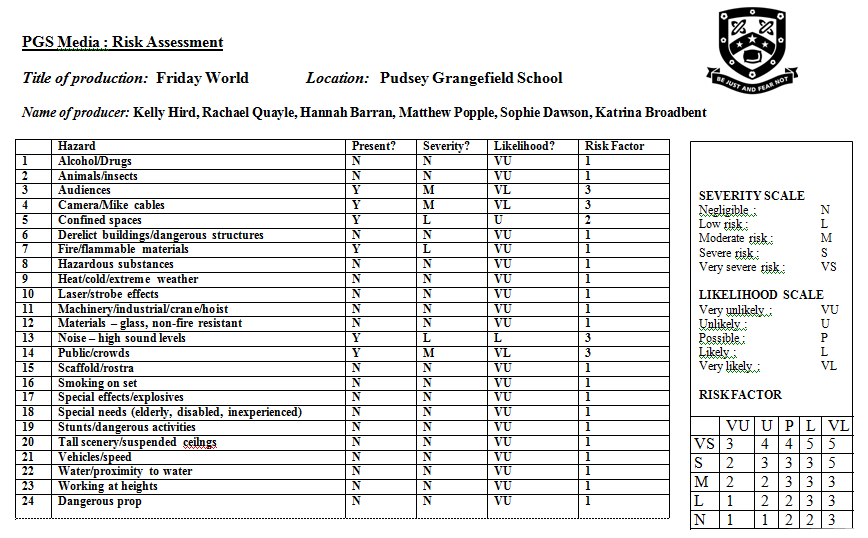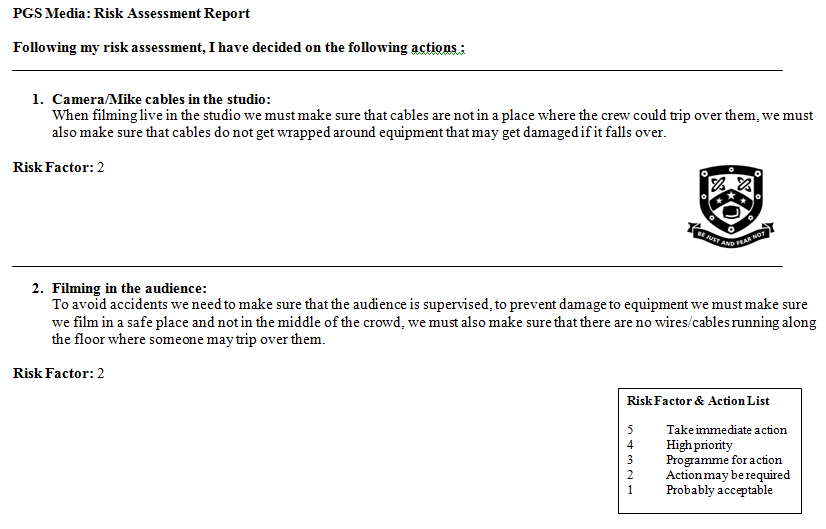Task 7 (P1,M1,D1)
The TV program we recorded was called Friday World and the role i played within my group was Sound Engineer.
Task 8 (P1,M1,D1)
Evaluation
Purpose:
The purpose of our TV program was to entertain, slightly inform and create light-hearted fun atmosphere for our target audience; high school students. We included a variety of short films, to appeal to the different styles of our target audience, these were:
Glee music video (This is very popular with teenagers at the moment)
Valentines Daydream "Scream" spoof (This was as we recorded our program close to Valentines day so we added comedy to the occasion)
Orchestra (This is a filming of a professional orchestra which came to the school, and some students got involved with this)
The conga (Students all participated in doing the conga around the school)
I think we achieved our purpose as the films we broadcasted had comedic and entertainment aspects and also, as it involved students from the school, it appealed to our target audience as they felt they were part of the program. Also the presenters were informative of up and coming events occurring within the school.
Audience:
As we had a live audience when we recorded our program we asked the audience after the production for their feedback and here are some of their comments:
"The camerawork was consistent and there were enough different shots used so that it remained interesting to watch."
"I liked it! It was very entertaining - all the way through."
"There was a part right at the beginning when I couldn't hear the presenters talking which confused me a little."
" I liked how it was quite cheerful and happy."
We were happy with this feedback and I agree with the comment about the sound of the presenters at the beginning and I have accepted that things can go wrong during a live production. I am glad that the program came across cheerful and happy as this ws the mood we were trying to create.
Representation issues:
As our program was for entertainment purposes, we gave out positive messages to create a light, fun atmosphere. For example we had a video of the students from our school doing the conga which was positive as it involved our target audience so it was especially entertaining for them. Our program involved males and females, both with the presenting and in the short films we broadcasted. We had one male presenter and one female presenter to bring different aspects to the program, and also the audience can relate to either one. We did not use different ethnic groups, as we did not have the opportunity to and it wasn't an issue.
As we had several short films within our multi-camera program, there was a number of music tracks used throughout the program. However they were all relevant to the mood we were trying to create of light-hearted, fun entertainment. For example the Glee music videos are very popular at the moment, therefore we chose it because of its entertaining, fun value. The location we used was the Friday world studio in our school. This was appropriate because its position means we can broadcast to the students efficiently. Also the studio was a satisfactory size for the equipment we used and for the presenters.
The language used by the presenters was informal and in their regional dialect which was suitable for the target audience as it is high school students therefore using formal language wouldn't be appropriate. Also they have the same regional dialect, so they could understand and relate to the presenters.
Technical issues:
The presenters used an omni-directional microphone which they both spoke into. It was important to use this microphone rather than a uni-directional microphone as the the sound needed to picked up from different directions. We had some technical difficulties with the sound at the beginning of the recording as we could not hear the presenters speaking at all. However this was quickly resolved by a technician within 30 seconds and we were able to hear the presenters clearly. At the time this cause a panic as we were not sure when the sound would come back, but we accepted that this can happen when recording a live program.
We used two cameras to film the presenters. One camera was set on a low-angle shot, the second camera was set on a medium shot of the presenters and we switched to close ups of each presenter throughout the recording. The camerawork was steady, and we used still shots rather than moving during a shot so not to confuse the audience. There was a slight hiccup at one point were the camera went to an extreme close up of one of the presenters faces, but this was quickly solved by moving out to a close up. I feel that there was enough variety to keep our audience interested, as the cuts to the presenters were short and sharp, and we used a number of shots.
Conventions/Narrative:
The following things are what i think is typical of the genre we chose:
-Comedy
-Informal
-Visual Effects
-A Variety of shots
-Bright colors
-Upbeat, appropriate music
-Entertainment
-Slightly inform
I think aspects of our program were similar to that of a professional product. We used bright, colorful backdrops behind the presenters which is a technique used by professionals in programs i have seen which are similar to our genre. The music we used throughout the production was upbeat and cheery which added to the mood we wanted to create of fun, happiness and entertainment which is similar to what professionals would do.
Professional producers will have many advantages compared to us. They will have a considerably bigger budget than us which will allow them to purchase high quality equipment and have a wider variety of music and sound effects. Also they have access to a large team of professionals which would mean that the production would get finished faster, saving time and money. Overall professional producers can produce a substantially better outcome.
Self evaluation and future targets:
I learnt many new skills during the filming of our multi-camera production. There were many different aspects involved, which I got to observe. The main skill I learnt was controlling the sound, as my role was sound engineer, however I also learnt about the different roles required for a multi-camera production. I was a little nervous about doing a live recording as I had never done it before and even though there was a hiccup with the sound at the beginning of the recording, I think I did well not to panic and I managed to do my job despite the pressure.
I think everyone in my group worked well together, and I was a good team member because I listened to other people’s opinions and there were no arguments within my group. We were organised during the planning which helped the process run more smoothly even when we had technical difficulties. In the future I will feel more confident taking part in live productions and would like to get experience doing different roles.








0 comments:
Post a Comment